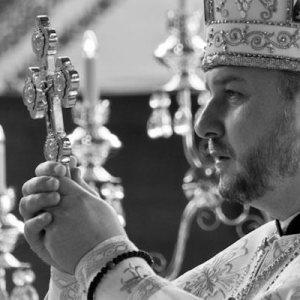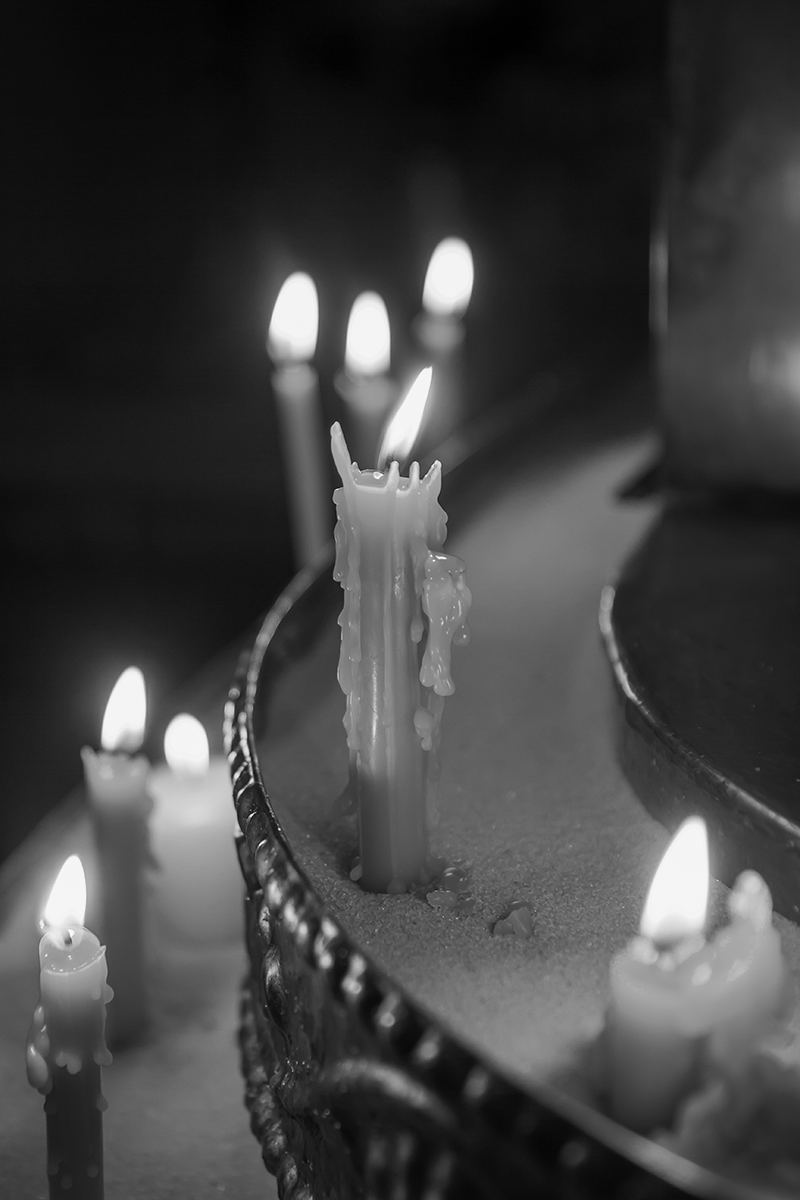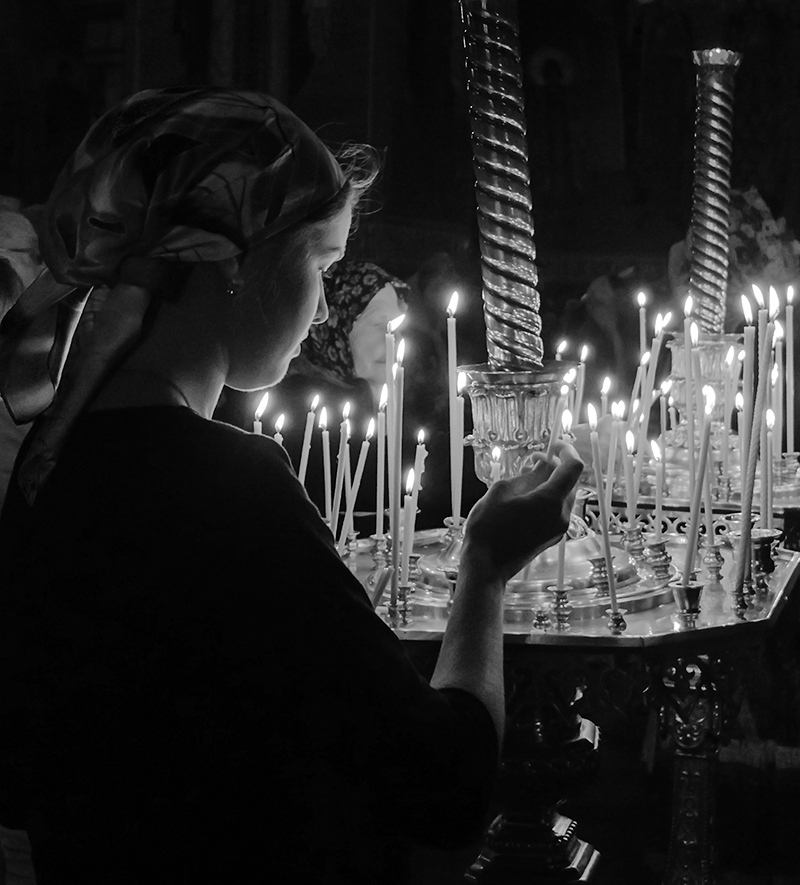
LXXXVI • Ч.2 лютий 2009 • February 2009 No.2 • LXXXVI
On the Meaning of Church Candles
— His Grace, Bishop Andriy
It is obvious that every human being has a physical existence, but that they also possess an interior, spiritual life. This life is hidden, mystical, and can only appear through some external subject or act. When, for example, a mother loves her child, she usually expresses her love by kissing the child, caressing its head, drawing it to her breast. The mother, therefore, shows her interior spiritual life through her external acts.
Thus a person, coming to Church, being conscious of their sinfulness, their spiritual fallenness, kneels and does prostrations, showing by this external movement their humility, for which according to the true word of the Bible God rewards a person with His Grace.
When a person feels in themselves the call of God, feels the need to express all the commitment of their soul and their love for God, they then often raise their hands on high, thirsting to draw near to their Heavenly Father.
When a person is worried, having committed sin and being conscious that punishment is due them for this evil committed against their nature and their God-given image because of the breaking of God’s commandments, they repent, wishing to free themselves from the sin and as a sign of this, according to the example of the publican, beat their breast and cry.
A mother, fearing the loss of her child, cries bitter tears before a holy icon, and prays, begging help, salvation for her child – the dearest treasure of a mother.
But all of this, consciousness of our unworthiness, our striving towards God, repentance, supplication and prayers are the product of the interior life of a person, and as mentioned, all these experiences lead to exterior acts.
Apart from this, there are many other interior experiences and thoughts which a person expresses in their prayers not only through exterior acts, but through physical things. Among these things wax church candles hold great meaning.

When a person, warmed by the desire to pray to God, enters the Church, hears the worthy and comforting Church singing, readings, and the exclamation of the great priestly prayers, sees before them the iconostas and in other areas of the temple wax church candles burning, lighted, quietly crackling – at that point many prayers and feelings well up in the heart of the pious and cause him to concentrate his attention first of all on the question “what is a candle” and “why is it for”?
Having considered this, the supplicant gives their own answer and becomes convinced, that the wax church candle has a very great meaning.
This is a pure gift, which is offered in sacrifice to God by human faith and generosity.
The unceasing labourer, the bee, fulfilling its God-given mandate, gathers from flowers the most-pure nectar and deposits it in its hive. From this nectar, wax hives and sweet, fragrant and healing honey is made.
This wax, made from the best, most-pure nectars of the flowers of the earth, are offered to God as a sacrifice by people. The flame shows the worthiness of the sacrifice to God from men, for by nature the flame is not only pure, but purifying.
And truly, how many feelings, how much faith, how much love is poured into these candles!
One was placed by the daughter of a sick mother, with a prayer for the healing of this dear person. Another was brought by a mother who prays for the good fortune of her family. A third was placed on the candlestand by a man who was brought to Church by the pure joy of faith, and who offers his prayerful praise to the Creator.
The limitlessness of diverse human feelings, attitudes and hopes are expressed in the candles which are offered by people before various icons in various temples.
Look with especial emotion at the thick column of candles which are placed by people “for the repose” of their relatives. Sometimes they are placed in a liturgical vessel with the memorial koliva (kutia), or in bread. The candles crackle quietly, as if crying, and little drops of wax drip down, hardening like tears. And we believe that from “up there”, from the heavenly mansions, our reposed see the faithful and painful love we who have been left on earth have for them, and from this experience heavenly joy.

What is the meaning of a candle?
We all should burn before the unconsumed fire, be aflame before Him through our faith, shine with the pure flame of our good deeds. And thus, having lit before the icons and placed our candles in church often, we seem to say:
“Have mercy, O Lord, and receive from me, the sinful and impure, this gift, offered to Thee with all my sincerity.
I know that it is small and worthless. I know that the clear flame of faith in Thee is required, that the pure fire of my good deeds is necessary to Thee. I know that my thoughts of Thee, which will never leave Thee, are necessary.
But from my weakness receive from me instead of the fire of faith and the flame of good deeds this small flame as a sign of my prayer to Thee.
And when I sleep, exhausted by the troubles of this life, or when sinful weakness invades my thoughts, may these flames before Thee shine and speak of my faithful, though weak, love of Thee. At least receive from me the light of these flames, receive them as a sign of a warm heart and a soul inflamed by the fire of faith.”
The great righteous man Seraphim had the following meaningful custom. Innumerable candles and oil lamps always burned in his cell. He lit them for the health and repose of all his spiritual children. He explained his custom thus:
“Many people who are generous to me bring me oil and candles, or offer money. I must pray for them and during my morning prayer rule I remember them all by name and say: remember, O Lord, all Thy servants, for whom I offer Thee these candles and this oil.”
Thus we endeavour to beautify our churches with candles. And this candle, placed before the holy icon out of our sincerity, warms our heart, opens it for the grace-giving gifts of God’s good will and our Lord receives them.
